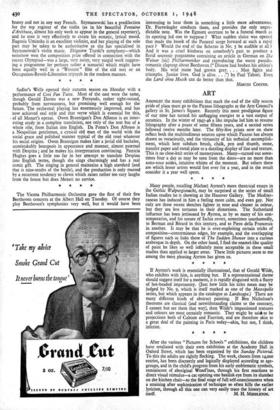ART
AMONGST the many exhibitions that mark the end of the silly season pride of place must go to the Picasso lithographs at the Arts Council's gallery in St. James's Square. Recently this most prodigious figure of our time has turned his unflagging energies to a vast output of ceramics. In the winter of 1945-46 a like impulse led him to resume lithography after a pause of some fifteen years, and a second series followed twelve months later. The fifty-five prints now on show reflect both the multitudinous sources upon which Picasso has always drawn so voraciously, and the virtuosity of his technical accomplish- ment, which here subdues brush, chalk, pen and thumb, stone, transfer paper and metal plate to a dazzling display of line and texture. This is no close-knit series of masterpieces. Many—turned out some- times four a day as may be seen from the dates—are no more than sotto-voce asides, intuitive whims of the moment. But others there are which lesser artists would fret over for a year, and in the result consider it a year well spent.
* * * * Many people, recalling Michael Ayrton's more theatrical essays in the Gothic Walpurgisnacht, may be surprised at the series of small Italian studies he is showing at the Hanover Gallery. The Mediter- ranean has induced in him a feeling more calm, and even gay. Not only are these recent sketches lighter in tone and cleaner in colour, but they are less tortuous in their distortions. The Sutherland influence has been jettisoned by Ayrton, as by so many of his con- temporaries, and his scenes of Ischia revert, sometimes unashamedly, to Berman and Berard in this century, and to Piero della Francesca in another. It may be that he is over-exploiting certain tricks of composition—conterminous edges, for example, and the overlapping of figures such as links those of The Sudden Shower into a curious arabesque in depth. On the other hand, I find the enamel-like quality of paint he likes so well infinitely more acceptable in these small studies than applied to larger areas. These little pictures seem to me among the most pleasing Ayrton has given us.
* * * * If Ayrton's work is essentially illustrational, that of Gerald Wilde, who exhibits with him, is anything but. If a representational theme should suggest itself for a moment, it is rapidly disguised with a flurry of hot-headed impetuosity. (Just how little his titles mean may be judged by No. 9, which is itself marked as one of the Metropolis series, but which appears in the catalogue as Landscape.) There are many different kinds of abstract painting. If Ben Nicholson's theorems are classical (and notwithstanding claims to the contrary, I cannot but see them that way), then Wilde's impassioned textures and colours are most certainly romantic. They might be said to be projections both of Cubism and Fauvism, and are therefore akin to a great deal of the painting in Paris today—akin, but not, I think, inferior.
After the various " Pictures for Schools" exhibitions, the children have retaliated with their own exhibition at the Academy Hall in Oxford Street, which has been organised by the Sunday Pictorial. To this the adults are rightly flocking. The work, chosen from 14,000 entries, has been discreetly and logically displayed according to age- groups, and in the child's progress from his early emblematic symbols, reminiscent of aboriginal Wond'inas, through his first reactions to direct visual stimulus—a cat opening one basilisk eye from its slumber on the kitchen chair—to the final stage of full self-consciousness when a straining after sophistication of technique so often kills the earlier lyricism, through all this one can very easily trace the history of art


































 Previous page
Previous page